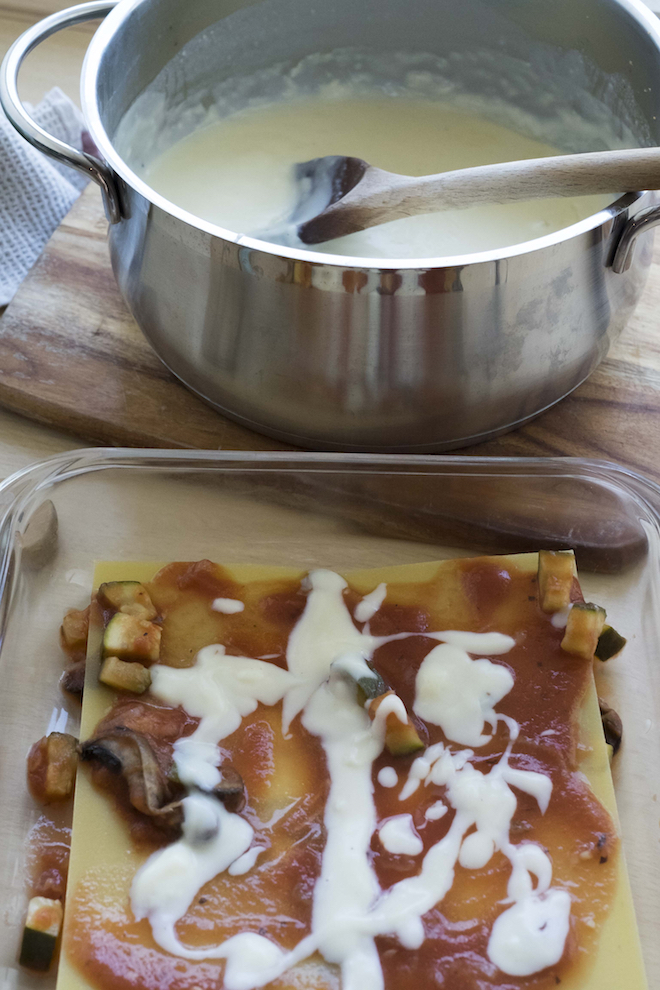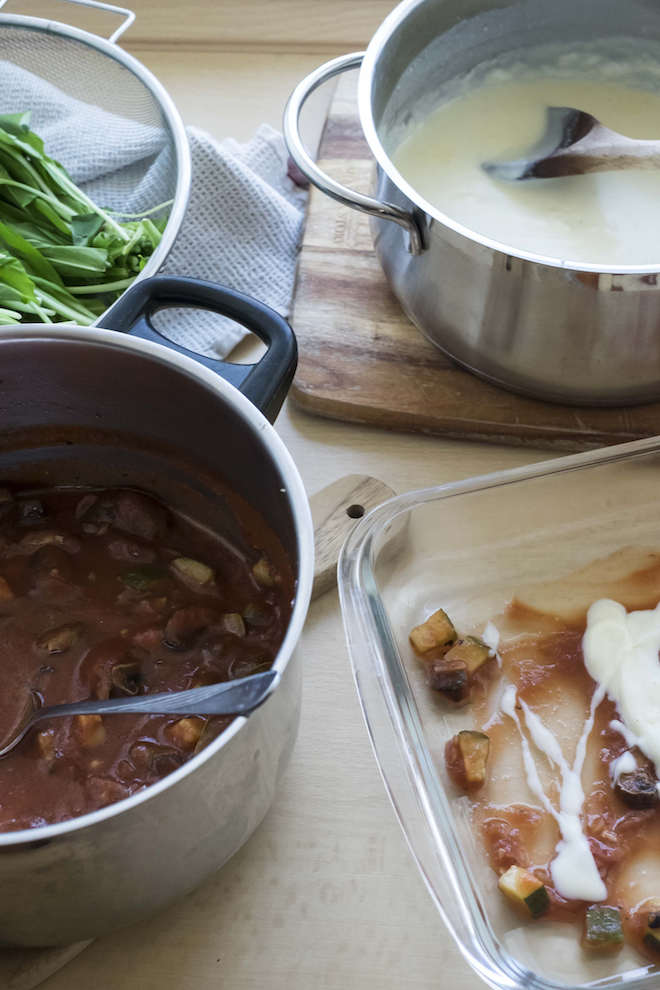 Vegetarian Lasagna Recipe
Vegetarian Lasagna Recipe
This Vegetarian Lasagna recipe is a staple in our home – I make it once a month at a minimum. The sauce, made from scratch is so easy to make and flavoursome – just onions, Passata, zucchini and mushrooms. My husband (an avid meat eater), still can’t believe it’s meat free.
In our small household, this small lasagna is the perfect size – one piece each on the night it’s made, and another piece each the next day (four servings total). Sometimes I serve the lasagna on its own, but mostly I like to add a salad on the side for freshness, and to feel like we’re balancing out the delicious but rich béchamel sauce.
This lasagna is quite easy to put together, but because you are making the sauce and the béchamel from scratch, a bit of time is required – perfect for preparing on weekends.
I hope you enjoy our vegetarian lasagna recipe as much as we do.
Jen x
Vegetarian Lasagna Recipe
Makes four servings/serves four people
SAUCE
1 medium sized zucchini, diced (200g)
6 – 7 button mushrooms, cleaned and finely sliced (100g)
250ml plain tomato Passata (set remaining Passata aside for use another day but keep the bottle)
1 small onion, peeled and finely diced (100g)
2 bay leaves
Water
Quality olive oil for frying
Salt and pepper to taste
Garlic powder (optional)
BÉCHAMEL
(adapted from Katie & Giancarlo Caldesi’s recipe)
100g unsalted butter
70g plain flour
500ml milk
1/2 small or medium sized onion, peeled
1 bayleaf
Nutmeg (ground), pinch
Salt and Pepper to taste
OTHER
8 packeted lasagna sheets (8cm x 17cm each)
Grana Padano or Parmigiano Reggiano, finely grated, 4 – 5 tbsp (see notes if you love cheese)
METHOD
Start the vegetarian lasagna by making the sauce. Add a tablespoon of olive oil to a medium/large sized pot on medium heat
Once the oil has heated up, add the finely diced onion, and stir for a minute or so then add the mushrooms and stir occasionally until the mushrooms soften, about five minutes. At this point, also feel free to add a little more oil if the pot is getting dry
After the mushrooms have softened, add the zucchini and stir until also softened, about five minutes. Again no need to be shy on the oil, add more if the pot is drying
When the zucchini have softened, pour in the Passata (it should cover half of the softened vegetable mixture). Fill your empty Passata bottle just under half way with water (about 300ml), shake the bottle (to catch all the sauce that’s stayed in the bottle) and pour onto the sauce. The mixture should now be just covered in sauce, if not add a little more water
Add the two bay leaves and stir through, then bring the sauce to a boil (about ten minutes), then reduce to low heat. Taste the sauce and adjust seasoning to your taste (a little more salt and pepper or even a bit of garlic powder – this is totally personal). Continue to let the sauce simmer as you make the béchamel sauce
To prepare the béchamel, in a medium sized saucepan add the milk, onion, bayleaf, nutmeg, salt and pepper together on low to medium heat, and bring it to a gentle boil
At the same time, in a small saucepan make a roux. On medium heat, melt the butter then add the flour and stir constantly until the ingredients form a thick paste and the flour has dissolved (do not overcook as it can lead to issues with your roux – this is a helpful read if so)
Remove the onion and bay leaf from the milk mixture and pour the roux in, stir vigorously until it thickens, (just a little less thick than custard), take the béchamel off the heat – stirring it occasionally to prevent a skin from forming on the top
Preheat your oven to 200 degrees or to the temperature given on the packet of your lasagna sheets
Take both saucepans (one with the sauce, and one with the béchamel) and place on chopping boards or a heat resistant surface. Place an oven proof dish for the lasagna roughly 20.5cm x 20.5cm and 4.5cm deep near both saucepans to make the layering of the lasagna easier
Start by adding two to three tablespoons of the lasagna sauce (be sure to remove the bay leaves) to the dish and spread the sauce out evenly across the whole base (including the corners). Drizzle one to two tablespoons of the béchamel over the sauce then place two lasagna sheets side by side over the sauces and press the sheets down a little

We continue this process until we get to the final two lasagna sheets. Press the last two lasagna sheets side by side to create the maximum amount of room for the final layer. Add the last of the lasagna sauce, then add a spoonful of béchamel sauce to the middle of the lasagna sauce mixture. The sauce will start to move so be gentle and slow as you spoon out the béchamel over the top, until the lasagna sauce is completely covered. Some of the béchamel will spill over the edges of the lasagna sheet layers creating a kind of béchamel mote, this is not an issue as it firms up in the cooking process and becomes one of the best parts of this dish
Finally, sprinkle the Grana Padano or Parmigiano over the béchamel evenly
Place the lasagna dish in the oven and bake for 30 – 35 minutes until the top is a golden brown (alternatively bake for the length of time stated on the packet of your lasagna sheets)
After cooking your vegetarian lasagna, allow it to cool slightly before serving
Serve with a fresh side salad or a good helping of steamed vegetables with your favourite dressing. Buon appetito!

Notes: This is the most basic form of my vegetarian lasagna recipe, which I always make and serve on the same day, and of course for a day or so after (normally we’ve eaten it all within 24 hours), I never freeze it.
I do have some variations to the recipe, here are a few that might be of interest. For the sauce, you can add in one or two diced tomatoes after the mushrooms. Also, ensure you get a good amount of the veggies in each spoonful of the sauce as you’re layering the lasagna.
Cheese – if you like Parmigiano/Grana Padano, triple the amount and sprinkle a little onto each layer after you’ve drizzled the béchamel.
The biggest challenge with lasagna is balancing the amount of béchamel-to-sauce ratio, so you have enough for the final layer. This comes with repetition and time, your flavour preferences will also develop and you’ll start to add ingredients that suit your palate and tastes.











